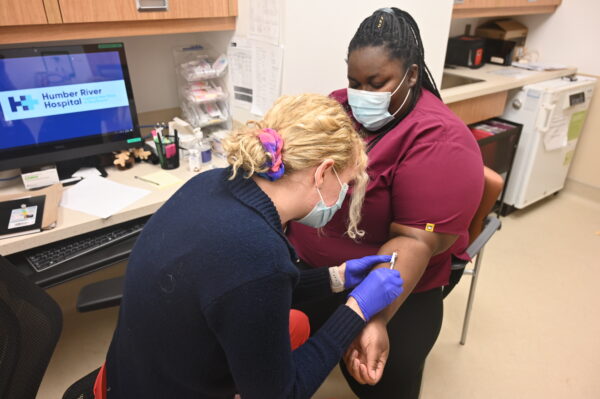World Tuberculosis Day
24
Mar
2022
March 24 marks World Tuberculosis Day, observed each year to raise awareness about tuberculosis (TB) and the ways in which society can work towards eliminating the disease. As an Occupational Health Nurse working at Humber River Health, Lynsay McPherson regularly conducts TB tests in the Occupational Health and Safety Department (OHSD). In recognition of the day, Lynsay has shared her insight into the disease, as well as the testing associated with it.

Tell us about your role.
I have been working in the OHSD as an Occupational Health Nurse at Humber River Health for roughly 18 months. My responsibilities include:
- Assisting with outbreak management for communicable disease per OHSA and IPAC guidelines
- Reviewing and processing medical information, always ensuring accuracy and confidentiality
- Performing walk-in assessments for occupational and non-occupational injuries
- Liaise with internal claims management staff, Workplace Safety and Insurance Board (WSIB), and medical personnel regarding any claim related issues
- Providing education and resources to employees and new hires
- Administering vaccines for new hires and current employees, including COVID vaccines
- Coordinate the seasonal influenza vaccination campaign and COVID-19 campaign
- Collaborate with multidisciplinary teams within the organization
What is Tuberculosis (TB)?
Tuberculosis (TB) is a disease caused by bacteria that is spread through the air from a person who is sick with TB to a person who is not, by coughing, laughing, speaking, or sneezing. It usually affects the lungs, but can affect any part of the body. However, only TB in the lungs or throat are infectious.
What are the signs or symptoms of TB?
Individuals with TB may experience some or all of the following symptoms:
- Blood in the sputum when coughing
- Cough of more than 3 weeks
- Fever or chills
- Loss of appetite
- Excessive fatigue
- Night sweats
- Swollen lymph nodes
- Chest pain
How is TB treated?
For any individual who has tested positive on the TB skin test, a chest X-ray is required in order to determine the type of TB. There are two types: latent TB and active TB. Latent TB is inactive and is not contagious, but it can potentially turn into active TB, which is why treatment is still important. Latent TB can be treated with medication that can prevent conversion to active TB. On the other hand, active TB has a more complicated treatment program that can differ for each individual. Both types require a medication regimen, which is prescribed and followed by your healthcare provider.
What is a TB Skin Test (TST)?
The Tuberculin Skin Test (TST) is administered to determine if you have been exposed to the TB bacteria. The fluid called Purified Protein Derivative (PPD) is injected into your forearm. This area must be checked 48-72 hours later to accurately see the result of the TST.
PPD is cultured on a synthetic medium. Therefore, an egg allergy is not a reason to withhold the TST, as an example. TST is not a vaccine and will not give you tuberculosis. Side effects are very uncommon- a few, extremely sensitive-skinned people may blister, develop ulcers, or find redness at the injection site.

Why is it important to do a TB test prior to starting certain jobs?
It is important to do a TB test as a preplacement requirement to understand an individual’s baseline. This may be an early detection tool in order to start treatment and isolate an individual. For those working with vulnerable populations, it provides a safer environment by decreasing the possible risk and spread of TB. Further education and knowledge can prevent further spreading into the community, which increases health and safety.

Why is World Tuberculosis Day important?
Early diagnosis and treatment is the most effective way to prevent the spread of tuberculosis. It is important to raise awareness of TB, as it is one of the world’s most infectious killers. The goal is to eliminate the spread and prevent TB worldwide. There is not enough knowledge and ongoing education provided. TB is a preventable and treatable disease, which is not highlighted enough.
Do you have any tips on preventing TB?
To prevent TB, individuals should:
- Wear PPE when around someone who is suspected to have TB
- Practice good hand hygiene
- Complete annual TB testing
- Keep your immune system strong
- Cover your mouth when you cough or sneeze
- Research your travel destination prior to travel for high risk TB settings and follow up with your health care provider
